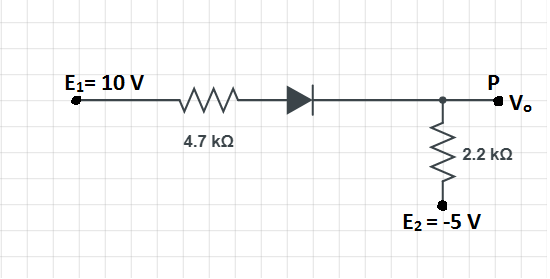
A silicon diode has a ‘knee voltage’ or a ‘threshold voltage of 0.7V. This Si diode connected in the circuit, as shown in the figure below. Calculate the voltage

A.
B.
C.
D.

Answer
503.7k+ views
2 likes
Hint: A diode in forward bias can be considered as an element that provides a potential drop in the circuit. In order to find the potential at point P, we have to use Kirchoff’s voltage law to find the current across the circuit. If we know the current across the circuit, we can find the potential at P.
Complete step by step answer:
Kirchoff’s voltage law states that the algebraic sum of all the potentials across a closed loop is zero. So, from the circuit, we can write,
Substituting the values in the above equation, we get,
The potential at point P is the potential across the resistor of resistance
So, the answer to the question is option (C).
Note: The p-n junction is the basic building block for many electronic devices like diodes, transistors, FET's etc..
When a p-type semiconductor and an n-type semiconductor forms an interface or boundary a p-n junction is formed.
A diode connected to a circuit in reverse bias shows a huge resistance typically in the mega-ohm range. So, we can say that the current flowing through the circuit in which the diode is connected in reverse bias is negligible or zero.
Kirchoff’s current law: This law states that the algebraic sum all the currents leaving and entering a junction in the circuit should be zero.
Kirchoff’s current law signifies the conservation of charge, while the Kirchoff’s voltage law signifies conservation of energy.
Complete step by step answer:
Kirchoff’s voltage law states that the algebraic sum of all the potentials across a closed loop is zero. So, from the circuit, we can write,
Substituting the values in the above equation, we get,
The potential at point P is the potential across the resistor of resistance
So, the answer to the question is option (C).
Note: The p-n junction is the basic building block for many electronic devices like diodes, transistors, FET's etc..
When a p-type semiconductor and an n-type semiconductor forms an interface or boundary a p-n junction is formed.
A diode connected to a circuit in reverse bias shows a huge resistance typically in the mega-ohm range. So, we can say that the current flowing through the circuit in which the diode is connected in reverse bias is negligible or zero.
Kirchoff’s current law: This law states that the algebraic sum all the currents leaving and entering a junction in the circuit should be zero.
Kirchoff’s current law signifies the conservation of charge, while the Kirchoff’s voltage law signifies conservation of energy.
Latest Vedantu courses for you
Grade 10 | CBSE | SCHOOL | English
Vedantu 10 CBSE Pro Course - (2025-26)
School Full course for CBSE students
₹37,300 per year
Recently Updated Pages
Master Class 9 General Knowledge: Engaging Questions & Answers for Success

Master Class 9 English: Engaging Questions & Answers for Success

Master Class 9 Science: Engaging Questions & Answers for Success

Master Class 9 Social Science: Engaging Questions & Answers for Success

Master Class 9 Maths: Engaging Questions & Answers for Success

Class 9 Question and Answer - Your Ultimate Solutions Guide

Trending doubts
Give 10 examples of unisexual and bisexual flowers

Draw a labelled sketch of the human eye class 12 physics CBSE

Differentiate between homogeneous and heterogeneous class 12 chemistry CBSE

Differentiate between insitu conservation and exsitu class 12 biology CBSE

What are the major means of transport Explain each class 12 social science CBSE

Draw a diagram of a flower and name the parts class 12 biology ICSE




